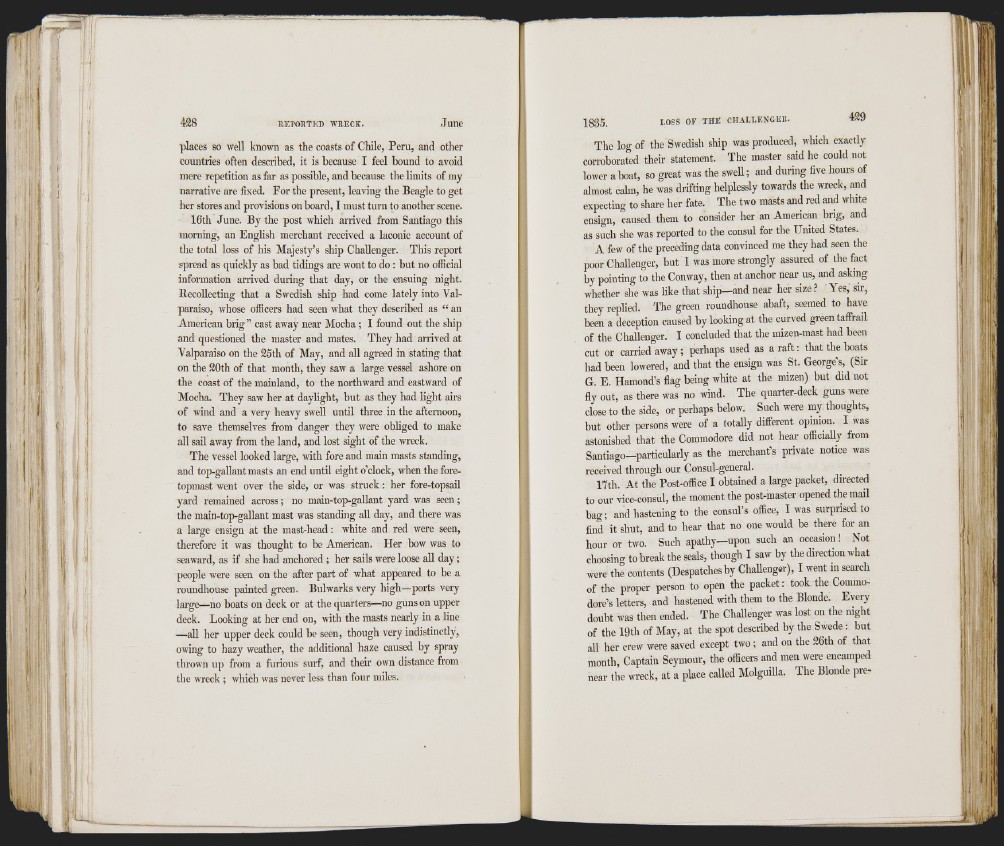
n . .j
n
»
‘I
>i 'S■ ;!
■■ ':«i ;
.illl
June
places so well known as the coasts of Chile, Peru, and other
countries often described, it is because I feel bound to avoid
mere repetition as far as possible, and because the limits of my
narrative are fixed. For the present, leaving the Beagle to get
her stores and provisions onboard, I must turn to another scene.
16th June. By the post which arrived from Santiago this
morning, an Fnglish merchant received a laconic account of
the total loss of his Majesty’s ship Challenger. This report
spread as quickly as bad tidings are wont to do : but no official
information arrived during that day, or the ensuing night.
Recollecting that a Swedish ship had come lately into Valparaiso,
whose officers had seen what they described as “ an
American brig” cast away near Mocha ; I found out the ship
and questioned the master and mates. They had arrived at
Valparaiso on the 25th of May, and all agreed in stating that
on the 20th of that month, they saw a large vessel ashore on
the coast of the mainland, to the northward and eastward of
Mocha. They saw her at daylight, but as they had light airs
of wind and a very heavy swell until three in the afternoon,
to save themselves from danger they were obliged to make
all sail away from the land, and lost sight of the wreck.
The vessel looked large, with fore and main masts standing,
and top-gallant masts an end until eight o’clock, when the foretopmast
went over the side, or was struck : her fore-topsail
yard remained across; no main-top-gallant yard was seen ;
the main-top-gallant mast was standing all day, and there was
a large ensign at the mast-head: white and red were seen,
therefore it was thought to be American. Her bow was to
seaward, as if she had anchored; her sails were loose all day;
people were seen on the after part of what appeared to be a
roundhouse painted green. Bulwarks very high—ports very
large—no boats on deck or at the quarters—no guns on upper
deck. Looking at her end on, with the masts nearly in a line
—all her upper deck could be seen, though very indistinctly,
owing to hazy weather, the additional haze caused by spray
thrown up from a furious surf, and their own distance from
the wreck ; which was never less than four miles.
The log of the Swedish ship was produced, which exactly
corroborated their statement. The master said he could not
lower a boat, so great was the swell; and during five hours of
almost calm, he was drifting helplessly towards the wreck, and
expecting to share her fate. The two masts and red and white
ensign, caused them to consider her an American brig, and
as such she was reported to the consul for the United States.
A few of the preceding data convinced me they had seen the
poor Challenger, but I was more strongly assured of the fact
by pointing to the Conway, then at anchor near us, and asking
whether she was like that ship—and near her size ? Yes, sir,
they replied. The green roundhouse abaft, seemed to have
been a deception caused by looking at the curved green taffrail
of the Challenger. I concluded that the mizen-mast had been
cut or carried away ; perhaps used as a ra ft: that tbe boats
bad been lowered, and that the ensign was St. George’s, (Sir
G. F. Hamond’s flag being white at the mizen) but did not
fly out, as there was no wind. The quarter-deck guns were
close to the side, or perhaps below. Such were my thoughts,
but other persons were of a totally different opinion. I was
astonished that the Commodore did not hear officially from
Santiago—particularly as the merchant’s private notice was
received through our Consul-general.
17th. At the Post-office I obtained a large packet, directed
to our vice-consul, the moment the post-master opened the mail
bao-; and hastening to the consul’s office, I was surprised to
find it shut, and to hear that no one would be there for an
hour or two. Such apathy-upon such an occasion! Not
choosing to break the seals, though I saw by the direction what
were the contents (Despatches by Challenger), I went in search
of the proper person to open the packet: took the Commodore’s
letters, and hastened with them to the Blonde. Fvery
doubt was then ended. The Challenger was lost on the night
of the 19th of May, at the spot described by the Swede: but
all her crew were saved except two ; and on the 26th of that
month. Captain Seymour, the officers and men were encamped
near the wreck, at a place called Molguilla. The Blonde pre-
111